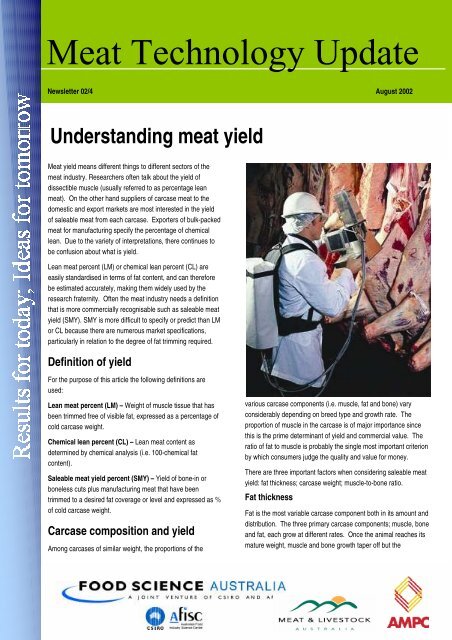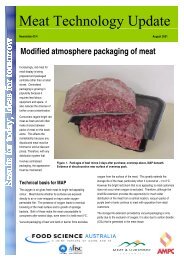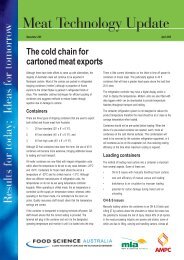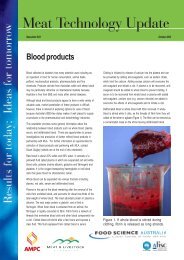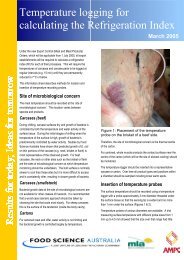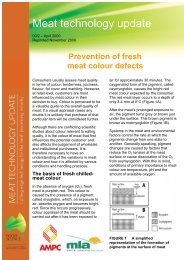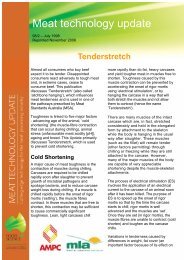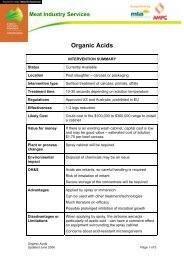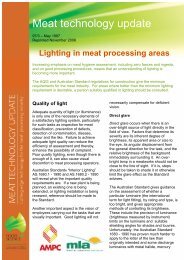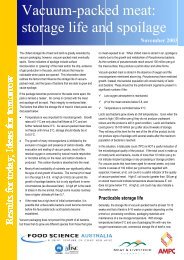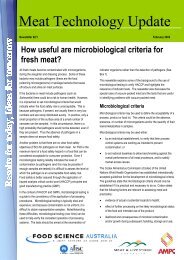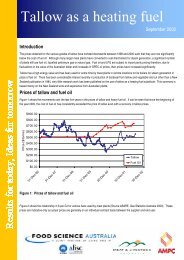Understanding Meat Yield - Red Meat Innovation
Understanding Meat Yield - Red Meat Innovation
Understanding Meat Yield - Red Meat Innovation
You also want an ePaper? Increase the reach of your titles
YUMPU automatically turns print PDFs into web optimized ePapers that Google loves.
<strong>Meat</strong> Technology UpdateNewsletter 02/4 August 2002<strong>Understanding</strong> meat yield<strong>Meat</strong> yield means different things to different sectors of themeat industry. Researchers often talk about the yield ofdissectible muscle (usually referred to as percentage leanmeat). On the other hand suppliers of carcase meat to thedomestic and export markets are most interested in the yieldof saleable meat from each carcase. Exporters of bulk-packedmeat for manufacturing specify the percentage of chemicallean. Due to the variety of interpretations, there continues tobe confusion about what is yield.Lean meat percent (LM) or chemical lean percent (CL) areeasily standardised in terms of fat content, and can thereforebe estimated accurately, making them widely used by theresearch fraternity. Often the meat industry needs a definitionthat is more commercially recognisable such as saleable meatyield (SMY). SMY is more difficult to specify or predict than LMor CL because there are numerous market specifications,particularly in relation to the degree of fat trimming required.Definition of yieldFor the purpose of this article the following definitions areused:Lean meat percent (LM) – Weight of muscle tissue that hasbeen trimmed free of visible fat, expressed as a percentage ofcold carcase weight.Chemical lean percent (CL) – Lean meat content asdetermined by chemical analysis (i.e. 100-chemical fatcontent).Saleable meat yield percent (SMY) – <strong>Yield</strong> of bone-in orboneless cuts plus manufacturing meat that have beentrimmed to a desired fat coverage or level and expressed as %of cold carcase weight.Carcase composition and yieldAmong carcases of similar weight, the proportions of thevarious carcase components (i.e. muscle, fat and bone) varyconsiderably depending on breed type and growth rate. Theproportion of muscle in the carcase is of major importance sincethis is the prime determinant of yield and commercial value. Theratio of fat to muscle is probably the single most important criterionby which consumers judge the quality and value for money.There are three important factors when considering saleable meatyield: fat thickness; carcase weight; muscle-to-bone ratio.Fat thicknessFat is the most variable carcase component both in its amount anddistribution. The three primary carcase components; muscle, boneand fat, each grow at different rates. Once the animal reaches itsmature weight, muscle and bone growth taper off but the
deposition of fat continues.It is possible to indirectly estimate the proportion of muscle in acarcase by estimating its overall fatness. The measurement of fatdepth has, as a consequence, become an important component ofcarcase classification schemes for beef, sheep and pork carcases,worldwide.There are major fat depots within the carcase. The first to bedeposited is the internal fat (kidney and channel fat), whichrepresents about 4% of the carcase weight. The ‘intermediate’ sitesof deposition are beneath the skin (subcutaneous fat) and betweenthe muscles (intermuscular fat). The remaining site of fat depositionis within the muscle (marbling). Marbling was thought to develop ata later age but this has recently been refuted. Fat deposition occurssimultaneously within the depots but at different rates depending onthe age of the animal.Carcase weightCarcase weight has a major influence, not only on the quantity ofthe various tissues, but also on the size of the individual muscleswithin the primal cuts. carcase weight is important, as therelationship between carcase weight and fatness varies betweenbreeds and also between grass and grain-fed animals.Furthermore, the individual weights of various muscles and primalcuts are highly related to the total weight of the carcase so anunderstanding of this relationship is important when attempting tomeet market specifications with regard to primal-cut weight.Muscle-to-bone ratioAfter accounting for weight and fatness, the remaining variation incarcase composition in mixed breed populations is largely explainedby differences in muscle: bone ratio. It is an important characteristicof any carcase in determining its ultimate value and, clearly, thehigher the muscle:bone ratio, the better the yield. The muscle:boneratio changes during growth and plateaus near its maximum value(around 5.1, 4.8 and 4.9 for bulls, steers and heifers, respectively)when animals reach about 50% of their mature weight. If animalsare slaughtered beyond 50% maturity, there is little need to considergrowth changes in this ratio. However, if an animal is slaughteredearlier than this, when its overall weight and proportion of muscleare both increasing, the weight of saleable meat and, therefore, thevalue of the carcase, will increase appreciably after small timeintervals (i.e. weeks). While this has remained an important criterionwhen assessing yield, the accurate estimation of the muscle:boneratio by means other than complete dissection of the carcase intocomponent parts, has remained elusive. Subjective assessments ofmuscle score (i.e. degree of muscling) have been used with varyingdegrees of success in live animal and carcase-classificationsystems as a proxy for muscle:bone ratio; however, such scores arestill constrained by the vagaries of subjective assessment.Production factors that influence yieldCarcase composition can be controlled, within limits, by modifyingthe factors that influence the growth of different tissues. Muscle isthe most desired tissue, bone is the least desired and fat is desiredin different amounts by different markets and consumers.The production variables that control fatness are breed, live weight(and maturity) at slaughter, sex, and nutrition. Growth promotantsare a recent short-term method for controlling fatness. They areused in approximately 90% of US lot-fed cattle and reasonablywidely throughout Australia. The most important determinantproducers will use when deciding how to manipulate carcasefatness will always be economic. The returns for producing leanerstock must be financially worthwhile to both producers andprocessors for it to occur.BreedThe genotype of the animal determines the potential for it todevelop particular carcase characteristics and meat quality.Genetic differences in yield and fatness traits have been observedbetween breeds and between strains within breeds.No single cattle breed has all the attributes that are needed toproduce beef efficiently in all environments, and to meet therequirements of all markets. The appropriate use of systematiccrossbreeding programs provides significant benefits to the beefindustry in terms of both yield and meat quality. Similar programsbenefit the sheepmeat industry.Carcase composition traits such as fat thickness and carcaseweight are moderately to highly heritable and breeding programsrespond well to genetic selection. Most estimates of beef andsheepmeat yield percentage are also moderately to highlyheritable. Therefore, producers can exploit the genetic variationthat exists to make rapid genetic gains in saleable meat yield.The table below indicates the results for carcase attributes frompurebred steers produced in the Germplasm Utilisation Program atthe US <strong>Meat</strong> Animal Research Center, Clay Center, Nebraska.BreedBritishCarcasewt (kg)Fat depth*(mm)Fat trim(%)SMY (%)<strong>Red</strong> Poll 315 7.62 22.4 62.6Hereford 306 11.68 25.5 60.1Angus 316 11.68 24.4 61.5EuropeanLimousin 330 4.32 13.4 72.3Simmental 348 4.06 15.5 68.4Charolais 348 3.56 15.0 68.7* Fat thickness 12/13 th rib (Adapted from Cundiff and Gregory, 1999)European breeds excelled in saleable meat yield but had difficultygrading USDA Choice because of lower levels of marbling. Britishbreeds excelled in USDA carcase-quality grade but had excessivefat thickness and percentage fat trim and reduced saleable meatyields.
MaturityMaturity is defined as the live weight of the animal where muscleand bone growth tapers off and fat deposition increases. The rateat which an animal matures has a major influence on its compositionat a given weight or age. Early-maturing types such as Britishbreeds yield less lean meat at a given weight and age than, say,Brahman crossbreds. Animals can be slaughtered at theappropriate live weight (and level of maturity) for a particular breedand sex as a means of controlling the level of fatness to thatrequired for a target market. For example, Hereford cattle would beslaughtered at an earlier age than Brahman crossbreds. Thealternative, and considerably more costly, strategy is to produceheavier, fatter animals and trim the meat back to the level of fatnessrequired by the marketplace.SexSex has a marked effect on the deposition of fat. Females matureat lighter weights than castrates or entire males. Under similarfeeding conditions, mature females will be fatter than castratemales, and castrates are fatter than entire males at a given weight.Therefore, females are slaughtered at lighter weights, otherwiseexcess fat will have to be trimmed from the carcase.NutritionDifferent components of diets can influence carcase fatness tovarying extents. In general, a fast-grown animal will be fatter thanits slower-grown counterpart. This is because at any stage ofgrowth there is some maximal rate of muscle growth, which appearsto be related to age as well as protein intake. Additional energyintake above maintenance is partitioned towards fat gain. Thefaster growing animal will also tend to have proportionally more ofits carcase fat as subcutaneous fat. It is important to recognise thatwhere grading systems use a measure of subcutaneous fatness todetermine the value of a carcase, those from fatter, faster-grownanimals are more likely to be downgraded than if the carcase weightalone is the major or sole criterion of value.When feed supply is restricted in the finishing phase to below adlibitum, the rate of fat deposition decreases but the rate of leandeposition is maintained. As a result, animals on a restricted diethave lower proportions of fat and higher proportions of lean thanunrestricted animals at the same weight. However, the effect on fatdeposition, due to restriction, decreases as the animal approachesmaturity. In this instance, the length of time and severity ofrestriction need to be greater for there to be a noticeable effect.Growth promotants have been developed to provide a cost-effectiveway of manipulating growth and carcase composition in order tofulfill the increasing need for more rapid turnoff and higher yields. Ingeneral they improve live weight gain, feed efficiency and LM ofmeat-producing animals. It should be noted that growth promotantshave a more variable (i.e. less predictable) effect on carcase fatthan they do on live weight.Processing factors that influence yieldWeight loss at various stages of processing probably leads to mostof the loss of potential yield. Weight losses can occur during thepre-slaughter phase, during chilling, transportation and retaildisplay, from vacuum packs (as weep), and during frozen storage.These factors will be discussed in a future article.The inability of boning-room staff to trim primal cuts consistently tothe desired specification contributes to variation in yield. Theyrequire information on each carcase in order to make informeddecisions on how best to utilise it.<strong>Yield</strong> estimationCalculations of the yield of a particular carcase or group ofcarcases can be done from a systematic series of weights: hotcarcase weight; cold carcase weight; weight of individual primalstrimmed to specification for the particular market; and weight oftrimmings. Comparison of the cold-carcase weight with the hotcarcaseweight provides a measure of the weight lost duringchilling. <strong>Yield</strong>s of saleable meat can be calculated for individualprimals, or groups of primals, or the aggregate of primals andtrimmings. Indicative weight ranges and yields for various beef andsheepmeat cuts are available in the AUS-MEAT, AustralianHandbook of Australian <strong>Meat</strong>. Whilst this approach provides veryreliable information, it is very labour-intensive and can only provideinformation once the carcases have been broken down. It isimpractical for routine use in commercial boning rooms.The widespread use of fat depth as a predictor has already beenmentioned. Techniques are now available that can be used topredict saleable beef yield and overall suitability of carcases forspecific markets. Considerable effort has been devoted toinvestigating alternative methods and technologies to predictcarcase yield and carcase composition. From the vast array ofapproaches the two most commercially viable options arediscussed below.Carcase assessmentThe combination of carcase weight and measurements of fatcoverage and depth have been reliably applied in commercialpractice to predict carcase yield and composition. The addition ofeye muscle area with this combination can improve the predictiveaccuracy, at least for some market categories.The carcase weight is available in practical circumstances atnegligible cost and is therefore used in most models of yieldprediction. The subcutaneous fat thickness of beef carcases isusually measured at the P8 site but is occasionally measured in theloin or rib regions. This measurement is commonly taken inAustralia using the simple cut-and-measure knife or alternatively bythe more sophisticated Hennessy Grading Probe. For sheep andlamb carcases, fat thickness can be measured using a GR knife orwith the AUS-MEAT Sheep Probe. Eye muscle area is usuallymeasured on the loin cross-section on the quartered side. This
may be measured manually or electronically by placing a plastic gridon the muscle surface.Video image analysis (VIA)VIAscan® is an electronic imaging technique developed in Australiato assess meat quality and saleable meat yield for beef sides andquarters, and sheep carcases. Systems have been developed toassess carcase-quality attributes and saleable meat yield. The firstsystem, the VIAscan® Beef Carcase System (BCS), providescarcase dimensions and objective colour measurements that arecalculated from a video image taken on-line on the slaughter floorwhich predicts saleable meat yield. Colour analysis gives fat andlean colour, and bruising. These performance measurements allowfor better carcase sorting and timely scheduling of boning activities.A second system, the VIAscan® Chiller Assessment System (orribeye camera), objectively measures ribeye area and shape,marbling, fat thickness, and lean and fat colour on quartered beefsides. The system is accredited by AUS-MEAT to report ChillerAssessment parameters. Measurements from this systemcomplement those taken from the BCS to provide more robustpredictions of yield across the commercial range of beef carcases.Whether utilized independently or in tandem, the VIA systemsprovide accurate and consistent data regarding the yield and qualityof beef carcases. They provide information on the suitability of aparticular carcase for any of a range of markets.The Sheep Carcase System has also been trialed extensively inAustralia and New Zealand and is now used commercially. It alsoprovides predictions of carcase lean meat yield at line speeds and isaccredited by AUS-MEAT to report AUS-MEAT GR Fat Score.Future prospectsMost consumers now demand more lean and less fat in the meatthey purchase. If processors and retailers have to trim off fatequivalent to, say, 5% of the weight of saleable meat, their yieldsare correspondingly reduced. As a result there is now a generalrecognition of the need to reduce the average fat content on beefand sheep carcases. A good understanding of why some animalsyield better than others, and access to cost-effective, practical andaccurate technologies in determining carcase composition, areessential to the meat industry in the future. It is inevitable thatthere will be wider adoption of procedures that make it possible todifferentiate carcases according to quality attributes for particularmarkets. The challenge for the meat industry is to be able tomaximise yields for each of these markets.Key points• Saleable meat yield (SMY) of cattle varies by more than 10%.• Fat is the most variable carcase component.• Breed, age at slaughter, nutrition, and sex have greatinfluence. Processing factors also affect SMY.• Reliable measurements of fat thickness and distribution areneeded for predictions of SMY.• Objective carcase assessment, eg. VIA, give reliablepredictions of yield and quality.The information contained herein is an outline only and should not be relied on in place of professional advice on any specific matter.For more information, contact one of the <strong>Meat</strong> Industry Services staff listed below.Food Science Australia <strong>Meat</strong> Industry Services SectionThe <strong>Meat</strong> Industry Services (MIS) Section of Food Science Australia is an initiative supported by <strong>Meat</strong> and Livestock Australia (MLA) and theAustralian <strong>Meat</strong> Processor Corporation (AMPC) to facilitate market access for, and support world-class practices in, Australia ’s meat industry.Need additional information help, information or advice? Contact any of the followingBRISBANE: Ian Eustace SYDNEY: MELBOURNE: ADELAIDE:Food Science Australia Ph. 07 3214 2117 Food Science Australia Food Science Australia PO Box 178PO Box 3312 Fax. 07 3214 2103 PO Box 181 Private Bag 16 FLAGSTAFF HILLTINGALPA DC QLD 4173 Mob. 0414 336 724 KURMOND NSW 2757 WERRIBEE Vic. 3030 SA 5159Neil McPhail Cheryl Masson Bill Spooncer Jocelyn Midgley Chris SentancePh. 07 3214 2119 Ph. 07 3214 2101 Ph. 02 4567 7952 Ph. 03 9731 3424 Ph. 08 8370 7466Fax. 07 3214 2103 Fax. 07 3214 2103 Fax. 02 4567 8952 Fax. 03 9731 3250 Fax. 08 8370 7566Mob. 0414 336 907 Mob. 0416 198 403 Mob. 0414 648 387 Mob. 0414 647 231 Mob. 0419 944 022Additional copies of this newsletter are available from: www.meatupdate.csiro.au


